Visit our Facebook Event Page
Admission: $10 General Admission/$5 for Cinematheque members
Advance tickets available here
Presented in association with Communication and Media Studies Department at Sonoma State University and the UC Berkeley Ethnic Studies Department
Sky Hopinka’s film work scrutinizes the layered structure of identity in relation to homeland, landscape and language. Like puzzles, his films are constructed with fragmented and superimposed images. Watching them is like experiencing memories inside of a dream, their fragments recomposed without any particular order by the unconscious. This does not make the result less truthful; quite the opposite, it is more real than ever. (Almudena Escobar López: Afterimage)
Indigenous American filmmaker Sky Hopinka’s (Ho-Chunk/Pechanga) video work centers around personal positions of homeland and landscape, the precarity of indigenous languages and the concomitant reality of language as a container of culture. While depicting lives and locations from the Bering Sea to Standing Rock, Hopinka’s vision of the North American landscape and its people is borderless and tentative, and inclusive of individual account and collective memory as grounding forces central to cultural survival and resistance. Avoiding a documentary approach to filmmaking in favor of a more nuanced and obliquely angled approach to cinematic ethnopoetics, Hopinka’s lushly visual films often allude to persons and places not present and hint at stories and histories untold and perhaps not completely knowable as disparate voices—familial, poetic, ancestral and contemporary—speak across time and distance.
Screening to include:
Visions of an Island (2016); digital video, color, sound, from the maker
An Unangam Tunuu elder describes cliffs and summits, drifting birds, and deserted shores. A group of students and teachers play and invent games revitalizing their language. A visitor wanders in a quixotic chronicling of earthly and supernal terrain. These visions offer glimpses of an island in the center of the Bering Sea.
wawa (2014); digital video, color, stereo, 6 minutes
Featuring speakers of chinuk wawa, an Indigenous language from the Pacific Northwest, wawa begins slowly, patterning various forms of documentary and ethnography. Quickly, the patterns tangle and become confused and commingled, while translating and transmuting ideas of cultural identity, language, and history.
Jáaji Approximately (2015); digital video, color, stereo, 8 minutes
Logging and approximating a relationship between audio recordings of my father and videos gathered of the landscapes we have both separately traversed. The initial distance between the logger and the recordings, of recollections and of songs, new and traditional, narrows while the images become an expanding semblance of filial affect. Jáaji is a near translation for directly addressing a father in the Hočąk language.
Venite et Loquamur (2015); digital video, b & w, stereo, 12 minutes
A group of students and teachers gather in an historical mansion in the woods of West Virginia for a week-long retreat in spoken Latin. I observe and I participate, navigating the errata with my camera.
Anti-Objects, or Space Without Path or Boundary (2017); digital video, color, stereo, 13 minutes
“The individual is not an autonomous, solitary object but a thing of uncertain extent, with ambiguous boundaries. So too is matter, which loses much of its allure the moment it is reduced to an object, shorn of its viscosity, pressure and density. Both subject and matter resist their reduction into objects. Everything is interconnected and intertwined.” —– Kengo Kuma
The title of this video, taken from the texts of the architect Kengo Kuma, suggests a way of looking at everything as “interconnected and intertwined”, as are the historical and the present, the tool and the artifact. Images and representations of two structures in the Portland Metropolitan Area that have direct and complicated connections to the Chinookan people who inhabit(ed) the land are woven with audio tapes of one of the last speakers of the Chinookan creole, chinuk wawa. These localities of matter resist their reduction into objects, and call anew for space and time given to wandering as a deliberate act and the empowerment of shared utility.
I’ll Remember You as You Were, Not as What You’ll Become (2016); video, color, stereo, 13 minutes
An elegy to Diane Burns on the shapes of mortality and being, and the forms the transcendent spirit takes while descending upon landscapes of life and death. A place for new mythologies to syncopate with deterritorialized movement and song, reifying old routes of reincarnation. Where resignation gives hope for another opportunity, another form, for a return to the vicissitudes of the living and all their refractions.
“I’m from Oklahoma I ain’t got no one to call my own.
If you will be my honey, I will be your sugar pie way hi ya
way ya hi ya way ya hi yo”
-Diane Burns (1957-2006)
Dislocation Blues (2017); digital video, color, stereo, 17 minutes
An incomplete and imperfect portrait of reflections from Standing Rock. Cleo Keahna recounts his experiences entering, being at, and leaving the camp and the difficulties and the reluctance in looking back with a clear and critical eye. Terry Running Wild describes what his camp is like, and what he hopes it will become.
Image Credit: I’ll Remember You as You Were, Not as What You’ll Become (2016) by Sky Hopinka
Download program notes
